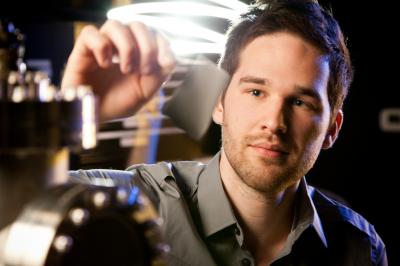Power Felt Converts Heat to Power
Researchers at Wake Forest University have developed a new technology called Power Felt, which is capable of converting body heat to electricity. Power Felt is constructed with carbon nanotubes that integrated in plastic that feels just like fabric, according to Wake Forest graduate student Corey Hewitt. As a thermoelectric device, it can create a charge simply be leveraging temperature differences.
"Generally thermoelectrics are an underdeveloped technology for harvesting energy. There is so much opportunity," Hewitt said. "We waste a lot of energy in the form of heat. For example, recapturing a car's energy waste could help improve fuel mileage and power the radio, air conditioning or navigation system." The difference between room and body temperature could be enough to deliver enough charge for a phone call, or a flashlight. On a bigger scale. Power Felt could be used as "piping" between the outside and inside of a house to help lower electricity bills.
Power Felt is still in its nascent stages and does not deliver enough power to make a case for mass production. At this time, the researchers have been able to stack 72 layers of carbon nanotubes, which deliver 140 nanowatts of power. They are now working on ways to add more layer and make the layers thinner to achieve greater power output. One day, they hope that Power Felt could only cost $1 to be added to a cellphone.
"I imagine being able to make a jacket with a completely thermoelectric inside liner that gathers warmth from body heat, while the exterior remains cold from the outside temperature," Hewitt said. "If the Power Felt is efficient enough, you could potentially power an iPod, which would be great for distance runners. It's definitely within reach."
Wake Forest University said it is in talks with investors to produce Power Felt commercially.
Get Tom's Hardware's best news and in-depth reviews, straight to your inbox.

Douglas Perry was a freelance writer for Tom's Hardware covering semiconductors, storage technology, quantum computing, and processor power delivery. He has authored several books and is currently an editor for The Oregonian/OregonLive.
-
amuffin The things this could do for everyone that uses Folding @ Home.Reply
CPU Loads, generates heat, powers PSU to power parts, repeat.
Lots of energy with minimal waste! -
nforce4max I wish that such development was given priority over less important things such as Facebook for example. We desperately need to move on from using old tech that is expensive and extremely limiting. Fossil fuels is so twentieth century, higher density sources of energy are needed and efficient use of energy needs be prioritized so that costs can go down.Reply -
DarkenMoon97 So, since I use my phone alot, I can keep it charged with my hands? YES YES A THOUSAND TIMES YES!Reply -
A Bad Day nforce4maxI wish that such development was given priority over less important things such as Facebook for example. We desperately need to move on from using old tech that is expensive and extremely limiting. Fossil fuels is so twentieth century, higher density sources of energy are needed and efficient use of energy needs be prioritized so that costs can go down.Reply
Here's what many investors will ask:
Will it generate quick profits with minimal risks and investments, or at least big enough profits to be gambled with?
Alternative energy requires big investment, and lacks the quick/large profits for many investors. -
ikyung nforce4maxI wish that such development was given priority over less important things such as Facebook for example. We desperately need to move on from using old tech that is expensive and extremely limiting. Fossil fuels is so twentieth century, higher density sources of energy are needed and efficient use of energy needs be prioritized so that costs can go down.Things like this is what generates projects like Facebook. Technology generates tools to be used by business minded people to generate capitol which creates jobs. Where do you think researchers get the funding?Reply
Science and technology is the wheel for prosperity.
-
Pennanen ugoing2"capable of converting body heat to electricity"... Does anyone remember The Matrix?Matrix was way ahead of its time anyways :DReply -
sixpac502 Imagine you just ate boiled eggs, broccoli and drank beer.......holy crap whats that smell....nothing man im just charging my Iphone.Reply
